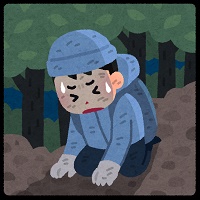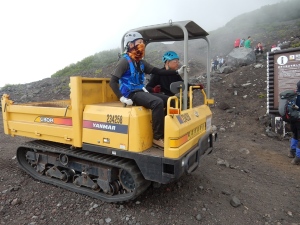Risk7: Fatigue

Unlike "altitude sickness" or "hypothermia", "fatigue" means you are too tired to walk.
No matter how hard it is, if you don't go down the mountain on your own, you won't be able to get home.
It's distressful when you can't go down the mountain by yourself.<Regarding the transportation system in case of distress incidents.>
Disstress incidents will be handled differently depending on the trails on Mt. Fuji.
In the case of the Yoshida Trail on the Yamanashi Prefecture side, the Mt. Fuji 5th Station General Management Center, which is operated by the prefecture, serves as a control center for information aggregation, etc. "Rescue teams" are organized by huts in cooperation with firefighters, etc. The injured and sick are brought down to the 5th station by a "crawler" transport vehicle. At the 5th Station, the injured are transported by ambulance to a local hospital or clinic.
In the case of Subashiri, Gotemba, Fujinomiya, and Summit trails, due to the difference in the number of injured and sick victims, these trails do not have a transportation system like Yoshida trail. Basically, the transportation is done by manpower by the police.
<Crawlers are not taxis!>

The photo on the right shows a vehicle, called a crawler, which is transporting goods to a hut. It also acts as a emergency transporter by the "rescue team" on the Yoshida trail as mentioned above. Emergency transportation by crawler is operated by a private enterprise. As such, the victim must pay for the transportation fee. In case of use of transport by crawler, the severity of victim's injury must require professional medical treatment. Upon arrival at the 5th station an ambulance will transport you to a local hospital or clinic. Occasionally, there are misunderstandings of this procedure, so please understand in advance.
Crawler operations incur various costs. Since the number of vechicles and drivers are limited, vehicles must be diverted to more serious life-threatening cases. A crawler is not a taxi. It's not something you can ride casually just because you're tired. It's also not just a matter of paying money. Again, please understand the circumstance.
Preventative measures
1) Strengthen your physical conditioning!
- Develop your legs by climbing nearby mountains
- Endurance training
2) A mountain climbing plan that fits your current physical strength
- Don't be overconfident (especially for middle-aged and elderly people).
- Plan to arrive at the hut before sunset.
- Especially for day climbers using a bus (whether or not you reach the summit), do your homework well in advance. Be sure you descend in time to take the last bus.


